Comparative Analysis: Healthcare Costs, Private vs. Medicare
VerifiedAdded on 2022/08/20
|8
|1918
|14
Essay
AI Summary
This essay provides a comprehensive analysis of the cost disparities in healthcare, specifically focusing on why private insurers often pay more for specialty drugs and medical services compared to their Medicare counterparts. The essay explores the impact of transparency rules, hospital pricing practices, and negotiation power on these differences. It highlights the lack of standard medical charges, the implications of the 300 'shoppable services' rule, and the absence of penalties for healthcare providers who exploit private insurers. The analysis contrasts the advantages Medicare insurers have, such as negotiated drug prices and protection against exploitation, which contribute to lower costs for their members. The essay also examines the role of rising drug demands and the limitations of private insurers in negotiating rates. The conclusion emphasizes the need for private insurers to advocate for their interests and secure better representation within the healthcare system to achieve fairer pricing and access to services. References include several studies and publications that support the arguments made throughout the essay.
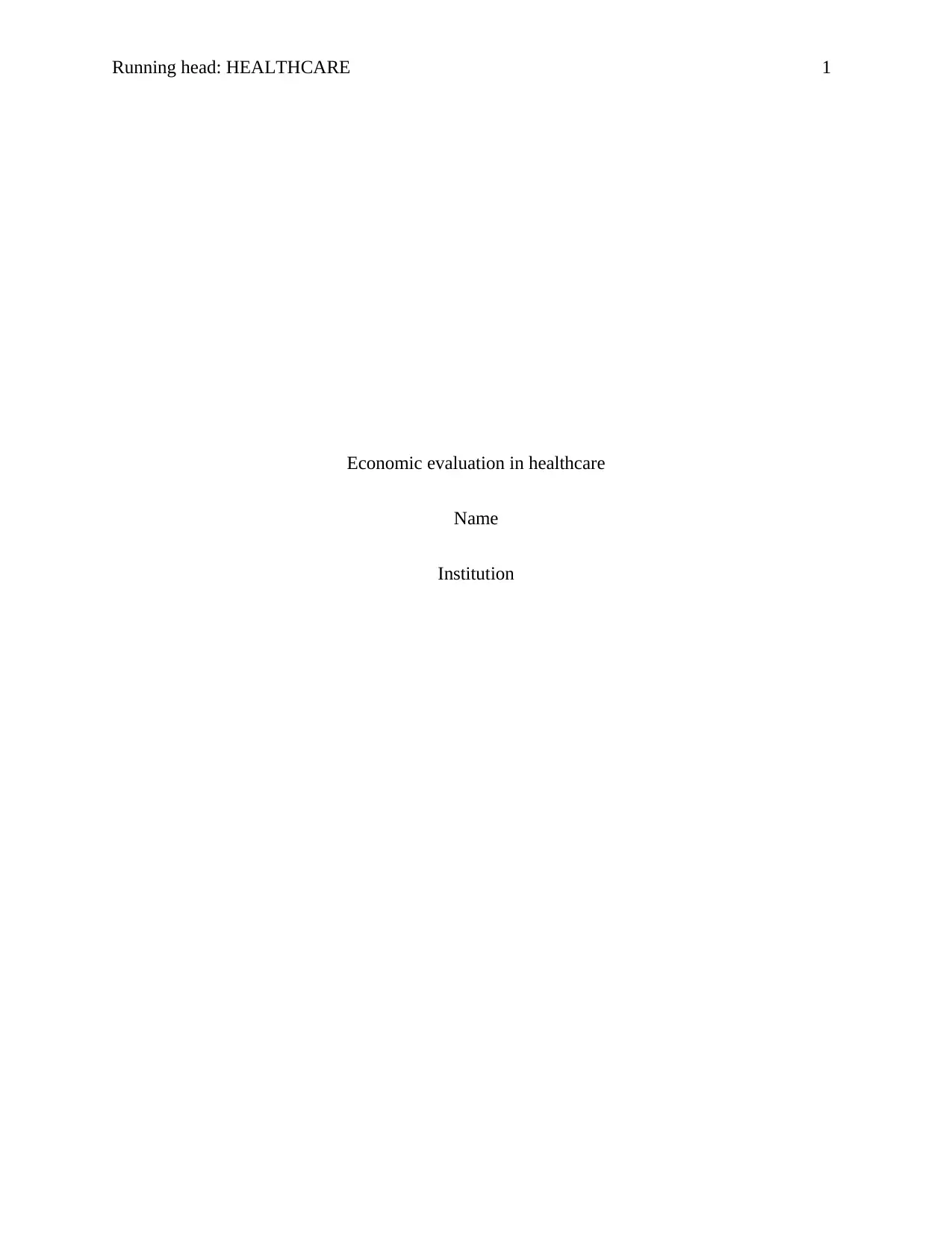
Running head: HEALTHCARE 1
Economic evaluation in healthcare
Name
Institution
Economic evaluation in healthcare
Name
Institution
Paraphrase This Document
Need a fresh take? Get an instant paraphrase of this document with our AI Paraphraser
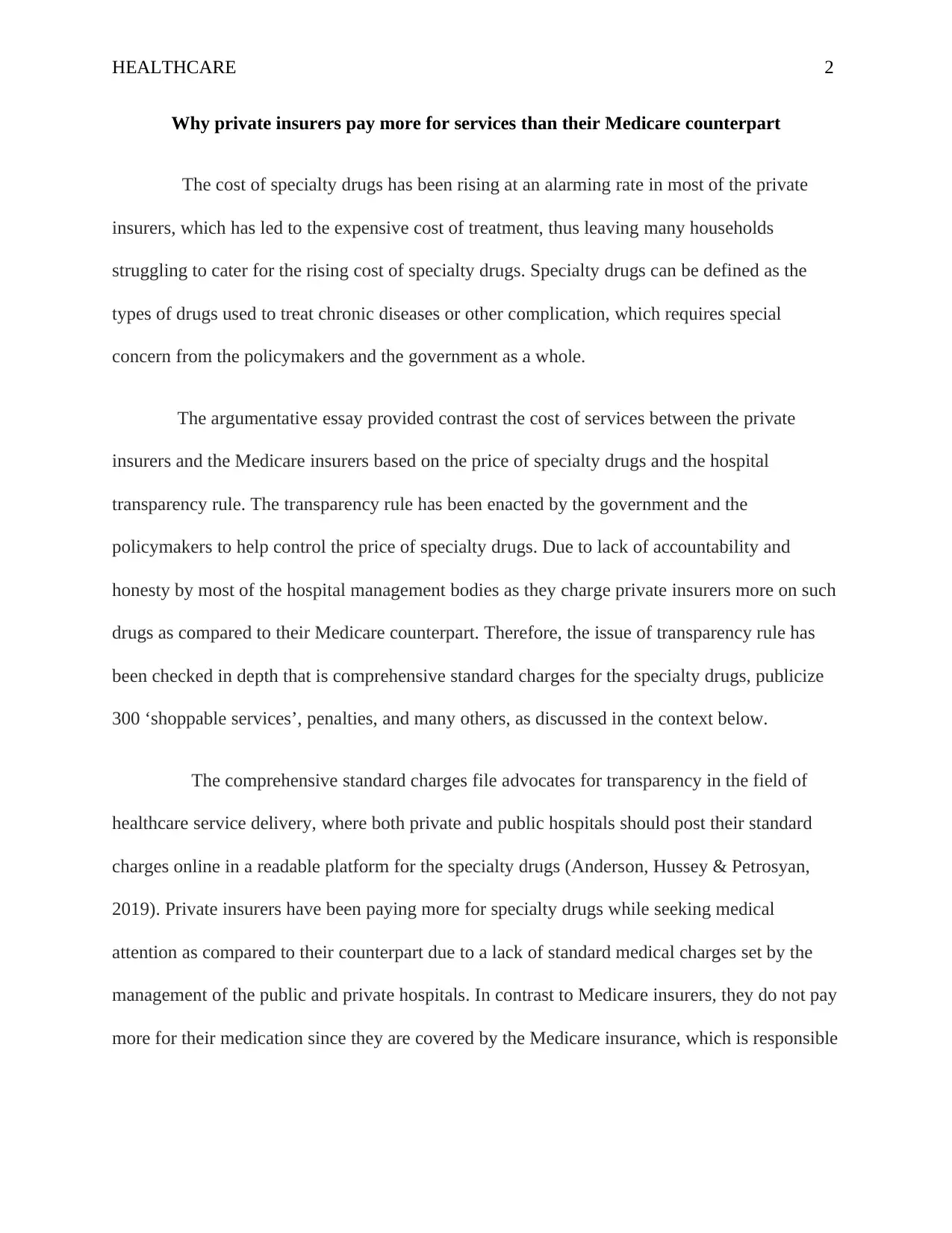
HEALTHCARE 2
Why private insurers pay more for services than their Medicare counterpart
The cost of specialty drugs has been rising at an alarming rate in most of the private
insurers, which has led to the expensive cost of treatment, thus leaving many households
struggling to cater for the rising cost of specialty drugs. Specialty drugs can be defined as the
types of drugs used to treat chronic diseases or other complication, which requires special
concern from the policymakers and the government as a whole.
The argumentative essay provided contrast the cost of services between the private
insurers and the Medicare insurers based on the price of specialty drugs and the hospital
transparency rule. The transparency rule has been enacted by the government and the
policymakers to help control the price of specialty drugs. Due to lack of accountability and
honesty by most of the hospital management bodies as they charge private insurers more on such
drugs as compared to their Medicare counterpart. Therefore, the issue of transparency rule has
been checked in depth that is comprehensive standard charges for the specialty drugs, publicize
300 ‘shoppable services’, penalties, and many others, as discussed in the context below.
The comprehensive standard charges file advocates for transparency in the field of
healthcare service delivery, where both private and public hospitals should post their standard
charges online in a readable platform for the specialty drugs (Anderson, Hussey & Petrosyan,
2019). Private insurers have been paying more for specialty drugs while seeking medical
attention as compared to their counterpart due to a lack of standard medical charges set by the
management of the public and private hospitals. In contrast to Medicare insurers, they do not pay
more for their medication since they are covered by the Medicare insurance, which is responsible
Why private insurers pay more for services than their Medicare counterpart
The cost of specialty drugs has been rising at an alarming rate in most of the private
insurers, which has led to the expensive cost of treatment, thus leaving many households
struggling to cater for the rising cost of specialty drugs. Specialty drugs can be defined as the
types of drugs used to treat chronic diseases or other complication, which requires special
concern from the policymakers and the government as a whole.
The argumentative essay provided contrast the cost of services between the private
insurers and the Medicare insurers based on the price of specialty drugs and the hospital
transparency rule. The transparency rule has been enacted by the government and the
policymakers to help control the price of specialty drugs. Due to lack of accountability and
honesty by most of the hospital management bodies as they charge private insurers more on such
drugs as compared to their Medicare counterpart. Therefore, the issue of transparency rule has
been checked in depth that is comprehensive standard charges for the specialty drugs, publicize
300 ‘shoppable services’, penalties, and many others, as discussed in the context below.
The comprehensive standard charges file advocates for transparency in the field of
healthcare service delivery, where both private and public hospitals should post their standard
charges online in a readable platform for the specialty drugs (Anderson, Hussey & Petrosyan,
2019). Private insurers have been paying more for specialty drugs while seeking medical
attention as compared to their counterpart due to a lack of standard medical charges set by the
management of the public and private hospitals. In contrast to Medicare insurers, they do not pay
more for their medication since they are covered by the Medicare insurance, which is responsible
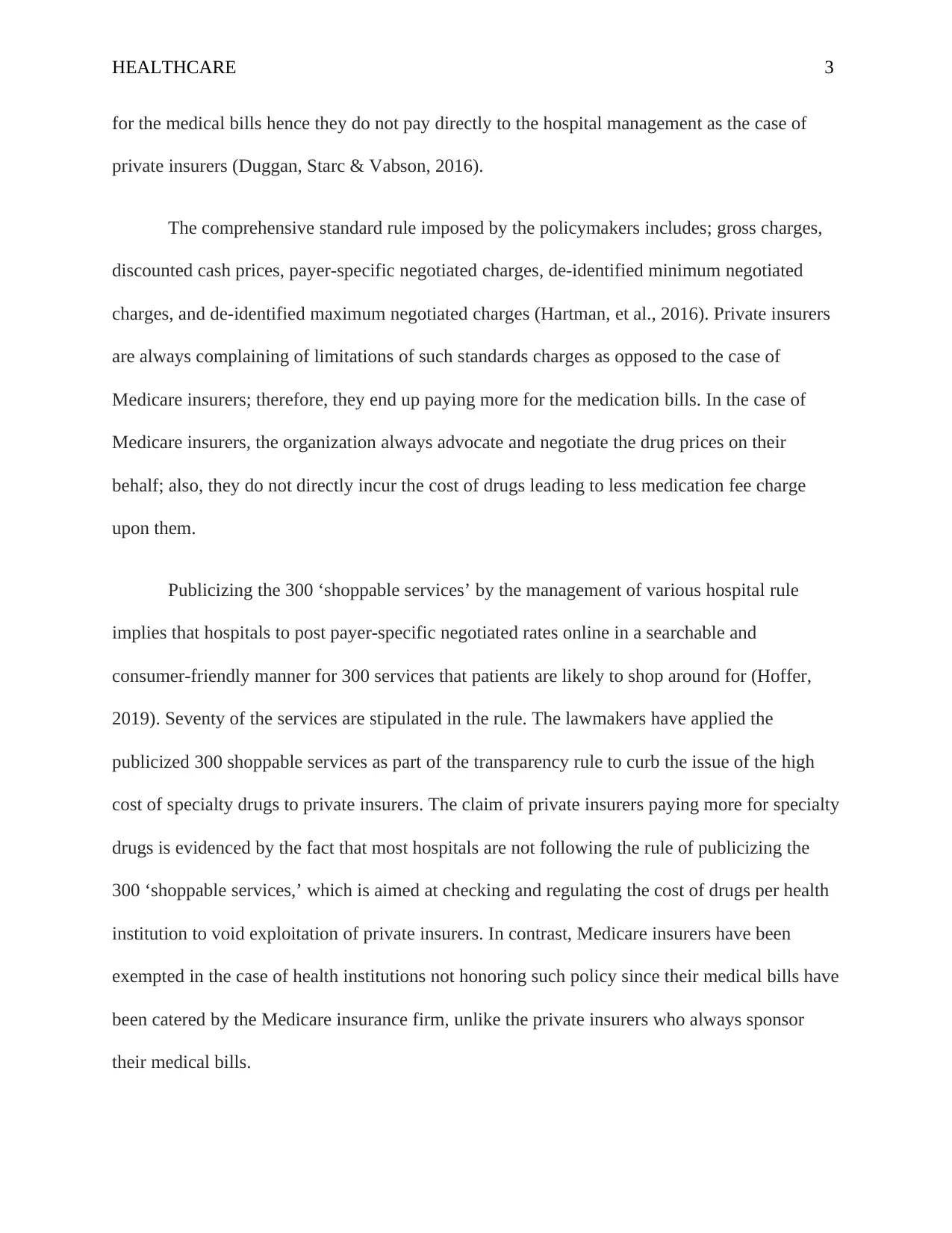
HEALTHCARE 3
for the medical bills hence they do not pay directly to the hospital management as the case of
private insurers (Duggan, Starc & Vabson, 2016).
The comprehensive standard rule imposed by the policymakers includes; gross charges,
discounted cash prices, payer-specific negotiated charges, de-identified minimum negotiated
charges, and de-identified maximum negotiated charges (Hartman, et al., 2016). Private insurers
are always complaining of limitations of such standards charges as opposed to the case of
Medicare insurers; therefore, they end up paying more for the medication bills. In the case of
Medicare insurers, the organization always advocate and negotiate the drug prices on their
behalf; also, they do not directly incur the cost of drugs leading to less medication fee charge
upon them.
Publicizing the 300 ‘shoppable services’ by the management of various hospital rule
implies that hospitals to post payer-specific negotiated rates online in a searchable and
consumer-friendly manner for 300 services that patients are likely to shop around for (Hoffer,
2019). Seventy of the services are stipulated in the rule. The lawmakers have applied the
publicized 300 shoppable services as part of the transparency rule to curb the issue of the high
cost of specialty drugs to private insurers. The claim of private insurers paying more for specialty
drugs is evidenced by the fact that most hospitals are not following the rule of publicizing the
300 ‘shoppable services,’ which is aimed at checking and regulating the cost of drugs per health
institution to void exploitation of private insurers. In contrast, Medicare insurers have been
exempted in the case of health institutions not honoring such policy since their medical bills have
been catered by the Medicare insurance firm, unlike the private insurers who always sponsor
their medical bills.
for the medical bills hence they do not pay directly to the hospital management as the case of
private insurers (Duggan, Starc & Vabson, 2016).
The comprehensive standard rule imposed by the policymakers includes; gross charges,
discounted cash prices, payer-specific negotiated charges, de-identified minimum negotiated
charges, and de-identified maximum negotiated charges (Hartman, et al., 2016). Private insurers
are always complaining of limitations of such standards charges as opposed to the case of
Medicare insurers; therefore, they end up paying more for the medication bills. In the case of
Medicare insurers, the organization always advocate and negotiate the drug prices on their
behalf; also, they do not directly incur the cost of drugs leading to less medication fee charge
upon them.
Publicizing the 300 ‘shoppable services’ by the management of various hospital rule
implies that hospitals to post payer-specific negotiated rates online in a searchable and
consumer-friendly manner for 300 services that patients are likely to shop around for (Hoffer,
2019). Seventy of the services are stipulated in the rule. The lawmakers have applied the
publicized 300 shoppable services as part of the transparency rule to curb the issue of the high
cost of specialty drugs to private insurers. The claim of private insurers paying more for specialty
drugs is evidenced by the fact that most hospitals are not following the rule of publicizing the
300 ‘shoppable services,’ which is aimed at checking and regulating the cost of drugs per health
institution to void exploitation of private insurers. In contrast, Medicare insurers have been
exempted in the case of health institutions not honoring such policy since their medical bills have
been catered by the Medicare insurance firm, unlike the private insurers who always sponsor
their medical bills.
⊘ This is a preview!⊘
Do you want full access?
Subscribe today to unlock all pages.

Trusted by 1+ million students worldwide
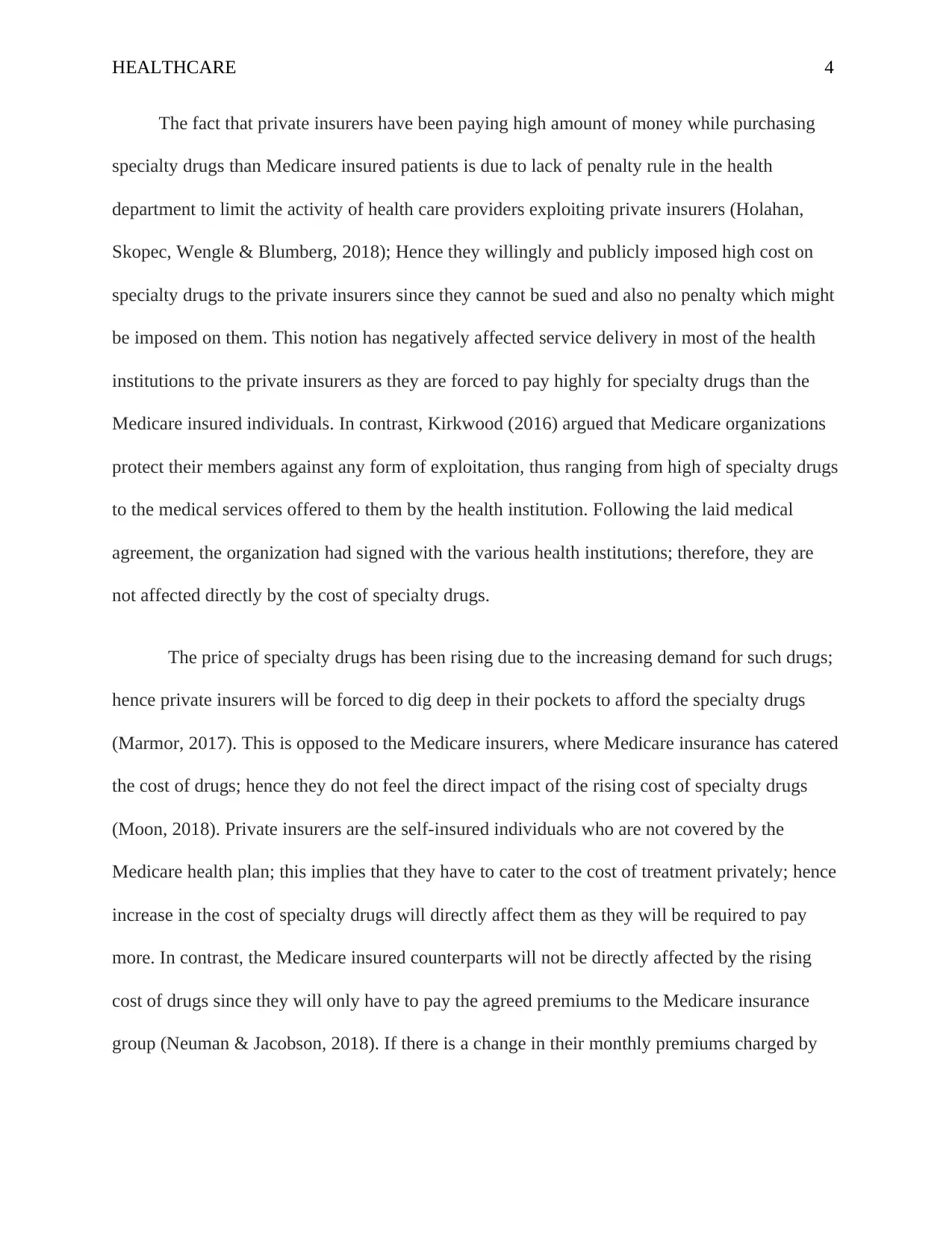
HEALTHCARE 4
The fact that private insurers have been paying high amount of money while purchasing
specialty drugs than Medicare insured patients is due to lack of penalty rule in the health
department to limit the activity of health care providers exploiting private insurers (Holahan,
Skopec, Wengle & Blumberg, 2018); Hence they willingly and publicly imposed high cost on
specialty drugs to the private insurers since they cannot be sued and also no penalty which might
be imposed on them. This notion has negatively affected service delivery in most of the health
institutions to the private insurers as they are forced to pay highly for specialty drugs than the
Medicare insured individuals. In contrast, Kirkwood (2016) argued that Medicare organizations
protect their members against any form of exploitation, thus ranging from high of specialty drugs
to the medical services offered to them by the health institution. Following the laid medical
agreement, the organization had signed with the various health institutions; therefore, they are
not affected directly by the cost of specialty drugs.
The price of specialty drugs has been rising due to the increasing demand for such drugs;
hence private insurers will be forced to dig deep in their pockets to afford the specialty drugs
(Marmor, 2017). This is opposed to the Medicare insurers, where Medicare insurance has catered
the cost of drugs; hence they do not feel the direct impact of the rising cost of specialty drugs
(Moon, 2018). Private insurers are the self-insured individuals who are not covered by the
Medicare health plan; this implies that they have to cater to the cost of treatment privately; hence
increase in the cost of specialty drugs will directly affect them as they will be required to pay
more. In contrast, the Medicare insured counterparts will not be directly affected by the rising
cost of drugs since they will only have to pay the agreed premiums to the Medicare insurance
group (Neuman & Jacobson, 2018). If there is a change in their monthly premiums charged by
The fact that private insurers have been paying high amount of money while purchasing
specialty drugs than Medicare insured patients is due to lack of penalty rule in the health
department to limit the activity of health care providers exploiting private insurers (Holahan,
Skopec, Wengle & Blumberg, 2018); Hence they willingly and publicly imposed high cost on
specialty drugs to the private insurers since they cannot be sued and also no penalty which might
be imposed on them. This notion has negatively affected service delivery in most of the health
institutions to the private insurers as they are forced to pay highly for specialty drugs than the
Medicare insured individuals. In contrast, Kirkwood (2016) argued that Medicare organizations
protect their members against any form of exploitation, thus ranging from high of specialty drugs
to the medical services offered to them by the health institution. Following the laid medical
agreement, the organization had signed with the various health institutions; therefore, they are
not affected directly by the cost of specialty drugs.
The price of specialty drugs has been rising due to the increasing demand for such drugs;
hence private insurers will be forced to dig deep in their pockets to afford the specialty drugs
(Marmor, 2017). This is opposed to the Medicare insurers, where Medicare insurance has catered
the cost of drugs; hence they do not feel the direct impact of the rising cost of specialty drugs
(Moon, 2018). Private insurers are the self-insured individuals who are not covered by the
Medicare health plan; this implies that they have to cater to the cost of treatment privately; hence
increase in the cost of specialty drugs will directly affect them as they will be required to pay
more. In contrast, the Medicare insured counterparts will not be directly affected by the rising
cost of drugs since they will only have to pay the agreed premiums to the Medicare insurance
group (Neuman & Jacobson, 2018). If there is a change in their monthly premiums charged by
Paraphrase This Document
Need a fresh take? Get an instant paraphrase of this document with our AI Paraphraser
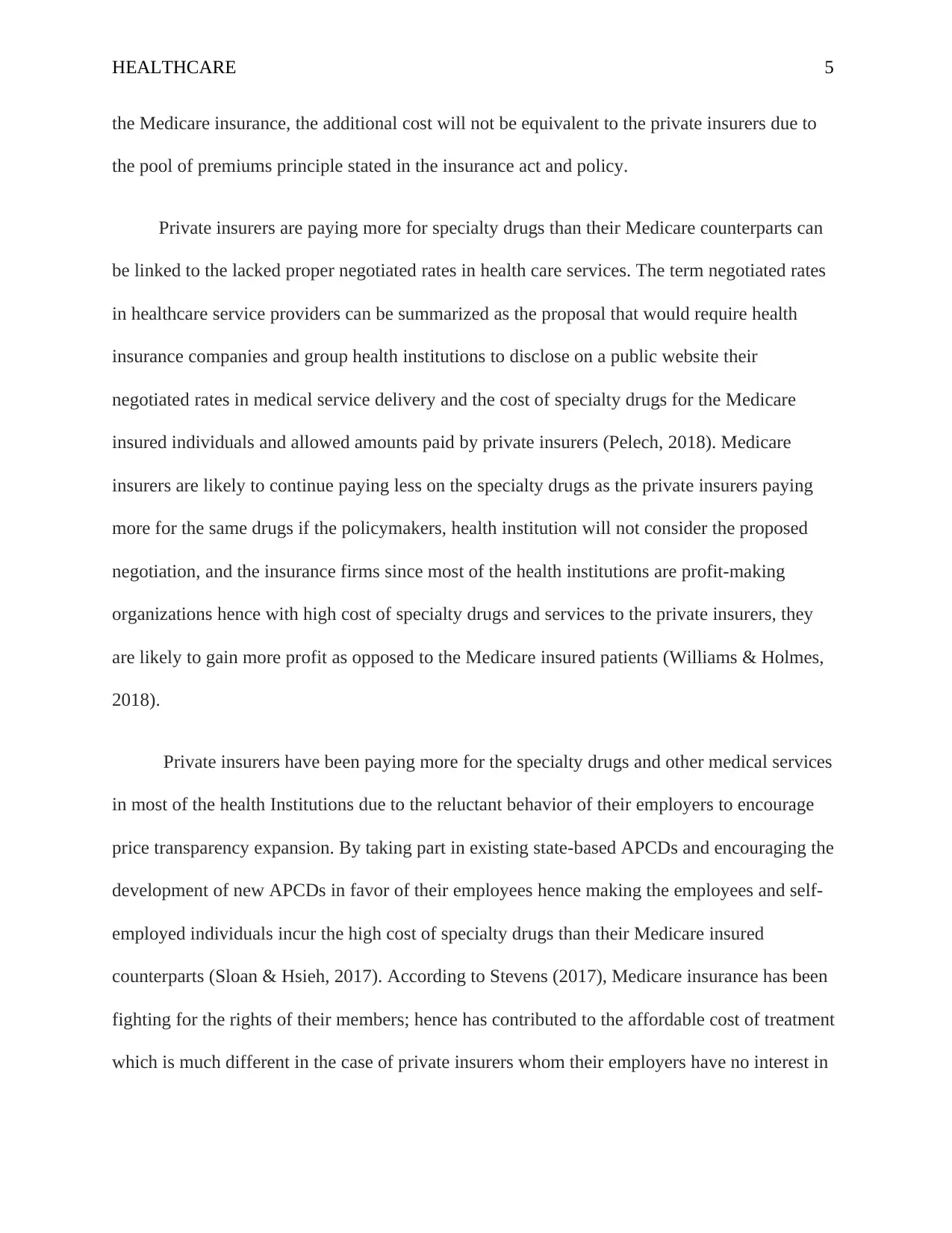
HEALTHCARE 5
the Medicare insurance, the additional cost will not be equivalent to the private insurers due to
the pool of premiums principle stated in the insurance act and policy.
Private insurers are paying more for specialty drugs than their Medicare counterparts can
be linked to the lacked proper negotiated rates in health care services. The term negotiated rates
in healthcare service providers can be summarized as the proposal that would require health
insurance companies and group health institutions to disclose on a public website their
negotiated rates in medical service delivery and the cost of specialty drugs for the Medicare
insured individuals and allowed amounts paid by private insurers (Pelech, 2018). Medicare
insurers are likely to continue paying less on the specialty drugs as the private insurers paying
more for the same drugs if the policymakers, health institution will not consider the proposed
negotiation, and the insurance firms since most of the health institutions are profit-making
organizations hence with high cost of specialty drugs and services to the private insurers, they
are likely to gain more profit as opposed to the Medicare insured patients (Williams & Holmes,
2018).
Private insurers have been paying more for the specialty drugs and other medical services
in most of the health Institutions due to the reluctant behavior of their employers to encourage
price transparency expansion. By taking part in existing state-based APCDs and encouraging the
development of new APCDs in favor of their employees hence making the employees and self-
employed individuals incur the high cost of specialty drugs than their Medicare insured
counterparts (Sloan & Hsieh, 2017). According to Stevens (2017), Medicare insurance has been
fighting for the rights of their members; hence has contributed to the affordable cost of treatment
which is much different in the case of private insurers whom their employers have no interest in
the Medicare insurance, the additional cost will not be equivalent to the private insurers due to
the pool of premiums principle stated in the insurance act and policy.
Private insurers are paying more for specialty drugs than their Medicare counterparts can
be linked to the lacked proper negotiated rates in health care services. The term negotiated rates
in healthcare service providers can be summarized as the proposal that would require health
insurance companies and group health institutions to disclose on a public website their
negotiated rates in medical service delivery and the cost of specialty drugs for the Medicare
insured individuals and allowed amounts paid by private insurers (Pelech, 2018). Medicare
insurers are likely to continue paying less on the specialty drugs as the private insurers paying
more for the same drugs if the policymakers, health institution will not consider the proposed
negotiation, and the insurance firms since most of the health institutions are profit-making
organizations hence with high cost of specialty drugs and services to the private insurers, they
are likely to gain more profit as opposed to the Medicare insured patients (Williams & Holmes,
2018).
Private insurers have been paying more for the specialty drugs and other medical services
in most of the health Institutions due to the reluctant behavior of their employers to encourage
price transparency expansion. By taking part in existing state-based APCDs and encouraging the
development of new APCDs in favor of their employees hence making the employees and self-
employed individuals incur the high cost of specialty drugs than their Medicare insured
counterparts (Sloan & Hsieh, 2017). According to Stevens (2017), Medicare insurance has been
fighting for the rights of their members; hence has contributed to the affordable cost of treatment
which is much different in the case of private insurers whom their employers have no interest in
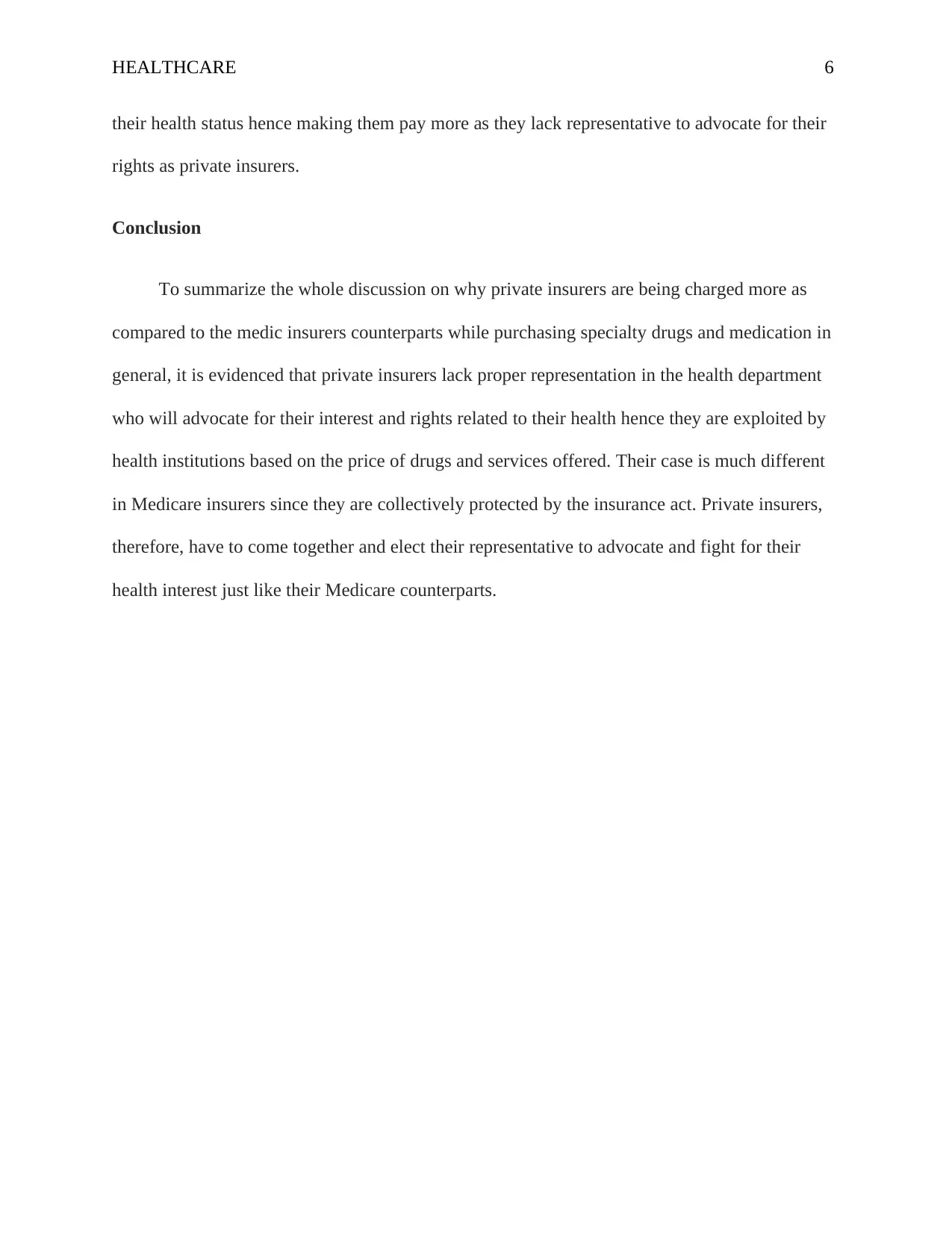
HEALTHCARE 6
their health status hence making them pay more as they lack representative to advocate for their
rights as private insurers.
Conclusion
To summarize the whole discussion on why private insurers are being charged more as
compared to the medic insurers counterparts while purchasing specialty drugs and medication in
general, it is evidenced that private insurers lack proper representation in the health department
who will advocate for their interest and rights related to their health hence they are exploited by
health institutions based on the price of drugs and services offered. Their case is much different
in Medicare insurers since they are collectively protected by the insurance act. Private insurers,
therefore, have to come together and elect their representative to advocate and fight for their
health interest just like their Medicare counterparts.
their health status hence making them pay more as they lack representative to advocate for their
rights as private insurers.
Conclusion
To summarize the whole discussion on why private insurers are being charged more as
compared to the medic insurers counterparts while purchasing specialty drugs and medication in
general, it is evidenced that private insurers lack proper representation in the health department
who will advocate for their interest and rights related to their health hence they are exploited by
health institutions based on the price of drugs and services offered. Their case is much different
in Medicare insurers since they are collectively protected by the insurance act. Private insurers,
therefore, have to come together and elect their representative to advocate and fight for their
health interest just like their Medicare counterparts.
⊘ This is a preview!⊘
Do you want full access?
Subscribe today to unlock all pages.

Trusted by 1+ million students worldwide
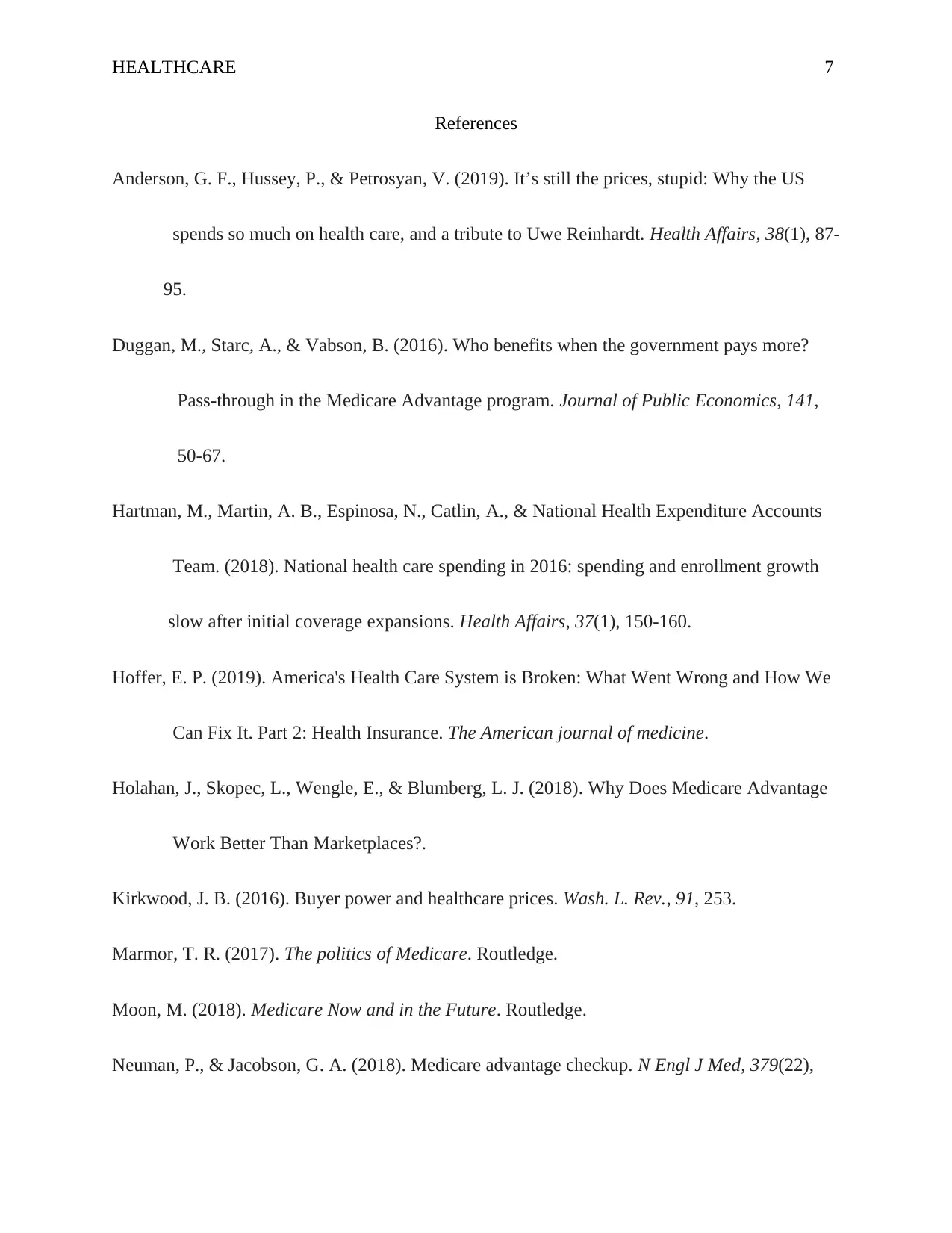
HEALTHCARE 7
References
Anderson, G. F., Hussey, P., & Petrosyan, V. (2019). It’s still the prices, stupid: Why the US
spends so much on health care, and a tribute to Uwe Reinhardt. Health Affairs, 38(1), 87-
95.
Duggan, M., Starc, A., & Vabson, B. (2016). Who benefits when the government pays more?
Pass-through in the Medicare Advantage program. Journal of Public Economics, 141,
50-67.
Hartman, M., Martin, A. B., Espinosa, N., Catlin, A., & National Health Expenditure Accounts
Team. (2018). National health care spending in 2016: spending and enrollment growth
slow after initial coverage expansions. Health Affairs, 37(1), 150-160.
Hoffer, E. P. (2019). America's Health Care System is Broken: What Went Wrong and How We
Can Fix It. Part 2: Health Insurance. The American journal of medicine.
Holahan, J., Skopec, L., Wengle, E., & Blumberg, L. J. (2018). Why Does Medicare Advantage
Work Better Than Marketplaces?.
Kirkwood, J. B. (2016). Buyer power and healthcare prices. Wash. L. Rev., 91, 253.
Marmor, T. R. (2017). The politics of Medicare. Routledge.
Moon, M. (2018). Medicare Now and in the Future. Routledge.
Neuman, P., & Jacobson, G. A. (2018). Medicare advantage checkup. N Engl J Med, 379(22),
References
Anderson, G. F., Hussey, P., & Petrosyan, V. (2019). It’s still the prices, stupid: Why the US
spends so much on health care, and a tribute to Uwe Reinhardt. Health Affairs, 38(1), 87-
95.
Duggan, M., Starc, A., & Vabson, B. (2016). Who benefits when the government pays more?
Pass-through in the Medicare Advantage program. Journal of Public Economics, 141,
50-67.
Hartman, M., Martin, A. B., Espinosa, N., Catlin, A., & National Health Expenditure Accounts
Team. (2018). National health care spending in 2016: spending and enrollment growth
slow after initial coverage expansions. Health Affairs, 37(1), 150-160.
Hoffer, E. P. (2019). America's Health Care System is Broken: What Went Wrong and How We
Can Fix It. Part 2: Health Insurance. The American journal of medicine.
Holahan, J., Skopec, L., Wengle, E., & Blumberg, L. J. (2018). Why Does Medicare Advantage
Work Better Than Marketplaces?.
Kirkwood, J. B. (2016). Buyer power and healthcare prices. Wash. L. Rev., 91, 253.
Marmor, T. R. (2017). The politics of Medicare. Routledge.
Moon, M. (2018). Medicare Now and in the Future. Routledge.
Neuman, P., & Jacobson, G. A. (2018). Medicare advantage checkup. N Engl J Med, 379(22),
Paraphrase This Document
Need a fresh take? Get an instant paraphrase of this document with our AI Paraphraser
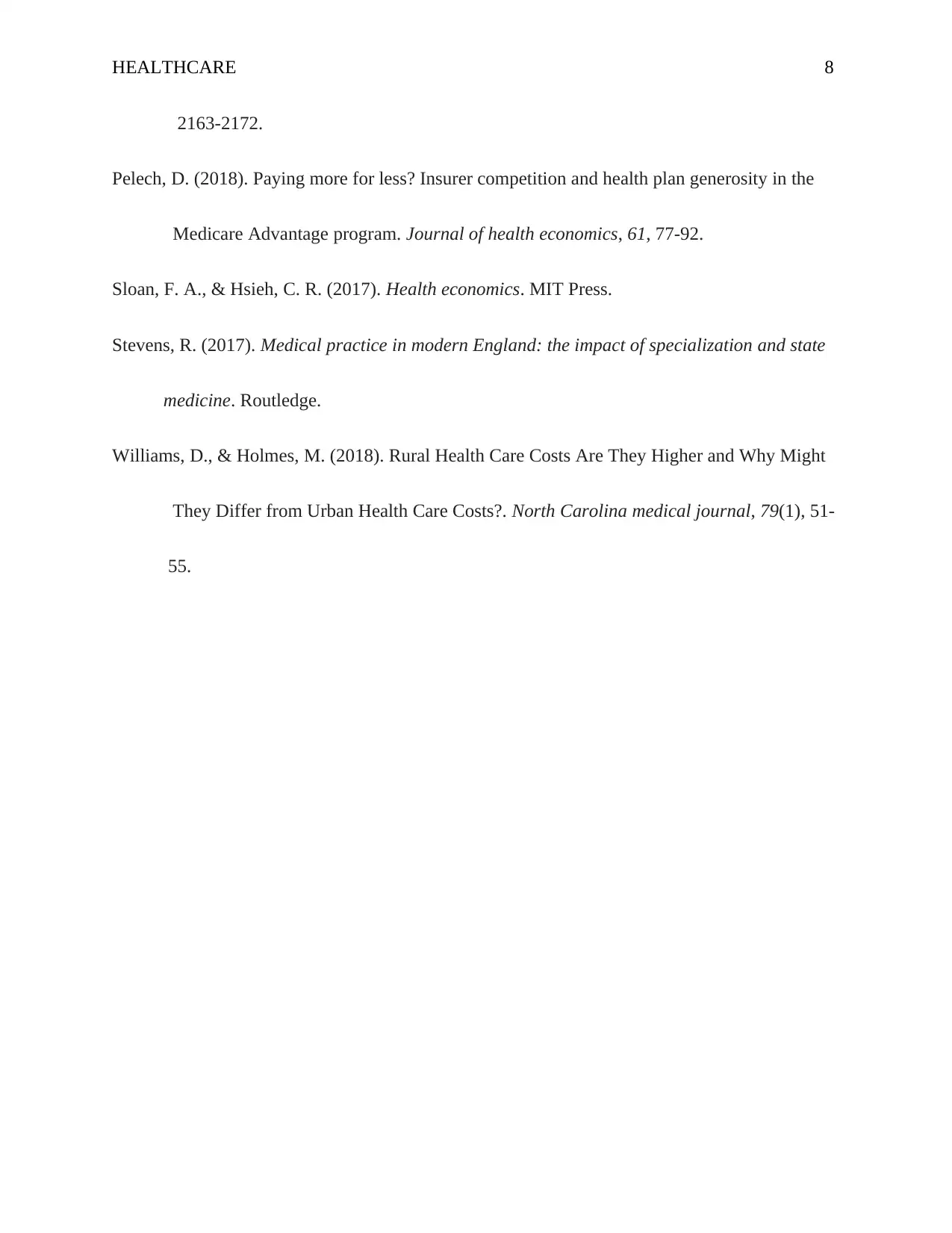
HEALTHCARE 8
2163-2172.
Pelech, D. (2018). Paying more for less? Insurer competition and health plan generosity in the
Medicare Advantage program. Journal of health economics, 61, 77-92.
Sloan, F. A., & Hsieh, C. R. (2017). Health economics. MIT Press.
Stevens, R. (2017). Medical practice in modern England: the impact of specialization and state
medicine. Routledge.
Williams, D., & Holmes, M. (2018). Rural Health Care Costs Are They Higher and Why Might
They Differ from Urban Health Care Costs?. North Carolina medical journal, 79(1), 51-
55.
2163-2172.
Pelech, D. (2018). Paying more for less? Insurer competition and health plan generosity in the
Medicare Advantage program. Journal of health economics, 61, 77-92.
Sloan, F. A., & Hsieh, C. R. (2017). Health economics. MIT Press.
Stevens, R. (2017). Medical practice in modern England: the impact of specialization and state
medicine. Routledge.
Williams, D., & Holmes, M. (2018). Rural Health Care Costs Are They Higher and Why Might
They Differ from Urban Health Care Costs?. North Carolina medical journal, 79(1), 51-
55.
1 out of 8
Related Documents
Your All-in-One AI-Powered Toolkit for Academic Success.
+13062052269
info@desklib.com
Available 24*7 on WhatsApp / Email
![[object Object]](/_next/static/media/star-bottom.7253800d.svg)
Unlock your academic potential
Copyright © 2020–2025 A2Z Services. All Rights Reserved. Developed and managed by ZUCOL.





